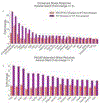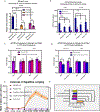Relationships between constitutive and acute gene regulation, and physiological and behavioral responses, mediated by the neuropeptide PACAP
- PMID: 34741979
- PMCID: PMC8900973
- DOI: 10.1016/j.psyneuen.2021.105447
Relationships between constitutive and acute gene regulation, and physiological and behavioral responses, mediated by the neuropeptide PACAP
Erratum in
-
Corrigendum to "Relationships between constitutive and acute gene regulation, and physiological and behavioral responses, mediated by the neuropeptide PACAP" [Psychoneuroendocrinology 135 (2022) 105447].Psychoneuroendocrinology. 2022 Jan;135:105592. doi: 10.1016/j.psyneuen.2021.105592. Epub 2021 Nov 17. Psychoneuroendocrinology. 2022. PMID: 34801296 Free PMC article. No abstract available.
Abstract
Since the advent of gene knock-out technology in 1987, insight into the role(s) of neuropeptides in centrally- and peripherally-mediated physiological regulation has been gleaned by examining altered physiological functioning in mammals, predominantly mice, after genetic editing to produce animals deficient in neuropeptides or their cognate G-protein coupled receptors (GPCRs). These results have complemented experiments involving infusion of neuropeptide agonists or antagonists systemically or into specific brain regions. Effects of gene loss are often interpreted as indicating that the peptide and its receptor(s) are required for the physiological or behavioral responses elicited in wild-type mice at the time of experimental examination. These interpretations presume that peptide/peptide receptor gene deletion affects only the expression of the peptide/receptor itself, and therefore impacts physiological events only at the time at which the experiment is conducted. A way to support 'real-time' interpretations of neuropeptide gene knock-out is to demonstrate that the wild-type transcriptome, except for the deliberately deleted gene(s), in tissues of interest, is preserved in the knock-out mouse. Here, we show that there is a cohort of genes (constitutively PACAP-Regulated Genes, or cPRGs) whose basal expression is affected by constitutive knock-out of the Adcyap1 gene in C57Bl6/N mice, and additional genes whose expression in response to physiological challenge, in adults, is altered or impaired in the absence of PACAP expression (acutely PACAP-Regulated Genes, or aPRGs). Distinguishing constitutive and acute transcriptomic effects of neuropeptide deficiency on physiological function and behavior in mice reveals alternative mechanisms of action, and changing functions of neuropeptides, throughout the lifespan.
Keywords: Neuropeptide; PACAP; Stress responding; Transcriptomics.
Copyright © 2021 Elsevier Ltd. All rights reserved.
Figures







References
-
- Allen Cell Types Database. 2015.
-
- Agarwal A, Halvorson LM, Legradi G, 2005. Pituitary adenylate cyclase-activating polypeptide (PACAP) mimics neuroendocrine and behavioral manifestations of stress: Evidence for PKA-mediated expression of the corticotropin-releasing hormone (CRH) gene. Brain Res Mol Brain Res 138, 45–57. - PMC - PubMed
-
- Botia B, Basille M, Allais A, Raoult E, Falluel-Morel A, Galas L, Jolivel V, Wurtz O, Komuro H, Fournier A, 2007. Neurotrophic effects of PACAP in the cerebellar cortex. Peptides 28, 1746–1752. - PubMed
Publication types
MeSH terms
Substances
Grants and funding
LinkOut - more resources
Full Text Sources
Molecular Biology Databases

